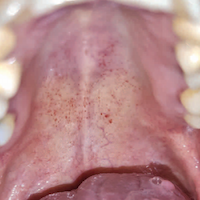Likelihood of Enanthem Among COVID-19 Patients with Skin Rash
Of the 21 patients included in the study with COVID-19 and skin rash, 29% had enanthem.

Previous research findings demonstrated skin manifestations described as erythematous rash, widespread uticaria, and chickenpox-like vesicles in patients in Italy with coronavirus disease 2019 (COVID-19). Other patients have reported other types of rashes, including petechial and purpuric changes, transient livedo reticularis, and acro-ischemic lesions.
Still, whether the manifestations are directly related to COVID-19 are unclear because viral infections and adverse drug reactions both frequently cause exanthems. A distinguisher, however, is the presence of enanthem, or oral cavity lesions.
Juan Jiminez-Cauhe, MD, and colleagues described different variants of enanthem in patients with COVID-19. The team of investigators included 21 patients from a tertiary care hospital who had both skin rash and COVID-19. The patients had their disease confirmed with a nasopharyngeal swab and required dermatology consultation from March 30 to April 8, 2020. The investigators classified enanthems into 4 categories: petechial, macular, macular with petechiae, or erythematovesicular.
Of the 21 patients included in the study with COVID-19 and skin rash, 29% had enanthem. The age of the patients ranged between 40 and 69 years old and a majority (66%) were female.
Among the different morphologies of the rash, erythema multiforme-like was the most common and observed in 3 patients. Purpuric periflexural was seen in 2 patients and papulovesicular was seen in 1 patient. The investigators did not observe enanthem in patients with urticarial or typical maculopapular rashes.
Jiminez-Cauhe and the team noted enanthem was macular in 1 patient, petechial in 2 patients, and macular with petechiae in 3 patients, and was located in the palate of all patients. There were no patients with an erythematovesicular enanthem.
The mean range from onset of COVID-19 symptoms and the appearance of mucocutaneous lesions was 12.3 days (range, -2 to 24 days). The range was shorter in patients with petechial enanthem compared to those with a macular lesion with petechiae appearance. There was no relation between drug intake and laboratory findings.
Although etiological diagnosis of exanthems may be challenging, useful clues include rash morphology, the associated symptoms, and the presence of enanthem. Petechial or vesicular pattern, involvement of buttocks or acral sites, and enanthem suggest an infectious etiology.
“Despite the increasing reports of skin rashes in patients with COVID-19, establishing an etiological diagnosis is challenging,” Jiminez-Cauhe and the study investigators wrote. “However, the presence of enanthem is a strong clue that suggests a viral etiology rather than a drug reaction, especially when a petechial pattern is observed.”
Still, based on the small sample size and the absence of a control group, the preliminary observations by the investigative team are limited.
The study, “Enanthem in Patients With COVID-19 and Skin Rash,” was published online in JAMA Dermatology.
Thumbnail and photo courtesy of JAMA Dermatology.